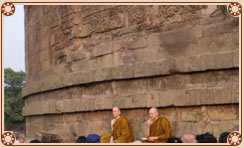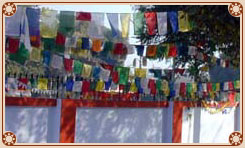Chandraprabha sanctuary is situated to the Southeast of Varanasi. Though one of India's lesser-known sanctuaries, Chandraprabha is endowed with beautiful picnic spots, dense forests, and scenic waterfalls like Rajdari and Devdari that attract a large number of tourists. The Chandraprabha sanctuary was established in May 1957. Asiatic lions were introduced at Chandraprabha in 1958. To start with the exercise was successful, with the number of lions rising from three to 11 by 1969. However, the next year the lions were found missing. The plan to put lions was again revived in 1993 but sadly not much has happened since then.
Flora And Fauna
A variety of wild animals and plant life are found at Chandraprabha. The animal life includes blackbucks, chital, sambhar, nilgai, wild boar, porcupine and Indian gazelle. The reptilian species include gharial and python. In terms of flora, it is a typical dry deciduous forest, composed of gneiss and laminated stone.
Reaching Chandraprabha
Chandraprabha sanctuary is about 55 km from Varanasi. The most convenient way to reach the Chandraprabha sanctuary is by hiring a taxi and driving down. The journey takes approximately two hours. The nearest rail junction is Varanasi, well connected to most parts of India.
Flora And Fauna
A variety of wild animals and plant life are found at Chandraprabha. The animal life includes blackbucks, chital, sambhar, nilgai, wild boar, porcupine and Indian gazelle. The reptilian species include gharial and python. In terms of flora, it is a typical dry deciduous forest, composed of gneiss and laminated stone.
Reaching Chandraprabha
Chandraprabha sanctuary is about 55 km from Varanasi. The most convenient way to reach the Chandraprabha sanctuary is by hiring a taxi and driving down. The journey takes approximately two hours. The nearest rail junction is Varanasi, well connected to most parts of India.
 Dhamekh Stupa, Sarnath" align="RIGHT" border="0" width="244" height="148">There are a number of historical and religious places and towns around Varanasi that are worth visiting. Some of the important and famous are Sarnath, Chunar, Jaunpur, Kaushambi, Kushinagar and Vindhaychal. Sarnath is about 10 km from Varanasi and is famous for being the place where Lord Buddha preached his first sermon after getting enlightenment. Sarnath is an important pilgrimage place for the Buddhists as it was here that the wheel of dharma was set in motion. Sarnath also boasts of a number of monuments and edifices ranging from the Ashokan period to the 12th century.
Dhamekh Stupa, Sarnath" align="RIGHT" border="0" width="244" height="148">There are a number of historical and religious places and towns around Varanasi that are worth visiting. Some of the important and famous are Sarnath, Chunar, Jaunpur, Kaushambi, Kushinagar and Vindhaychal. Sarnath is about 10 km from Varanasi and is famous for being the place where Lord Buddha preached his first sermon after getting enlightenment. Sarnath is an important pilgrimage place for the Buddhists as it was here that the wheel of dharma was set in motion. Sarnath also boasts of a number of monuments and edifices ranging from the Ashokan period to the 12th century.
 Benares, Varanasi" align="RIGHT" border="0" width="245" height="148">The art and culture of Varanasi is unique. It is the rich cultural tradition of Varanasi that makes it the cultural capital of India. A combination of archaeology, mythology, geography, art and history makes Varanasi a great center of Indian culture. Though Varanasi is associated mainly with Hinduism and Buddhism but one can find glimpse of many religious beliefs, types of worship and religious institutions at Varanasi. It is amazing to see the primitive worship cults being practiced at Varanasi.
Benares, Varanasi" align="RIGHT" border="0" width="245" height="148">The art and culture of Varanasi is unique. It is the rich cultural tradition of Varanasi that makes it the cultural capital of India. A combination of archaeology, mythology, geography, art and history makes Varanasi a great center of Indian culture. Though Varanasi is associated mainly with Hinduism and Buddhism but one can find glimpse of many religious beliefs, types of worship and religious institutions at Varanasi. It is amazing to see the primitive worship cults being practiced at Varanasi.




